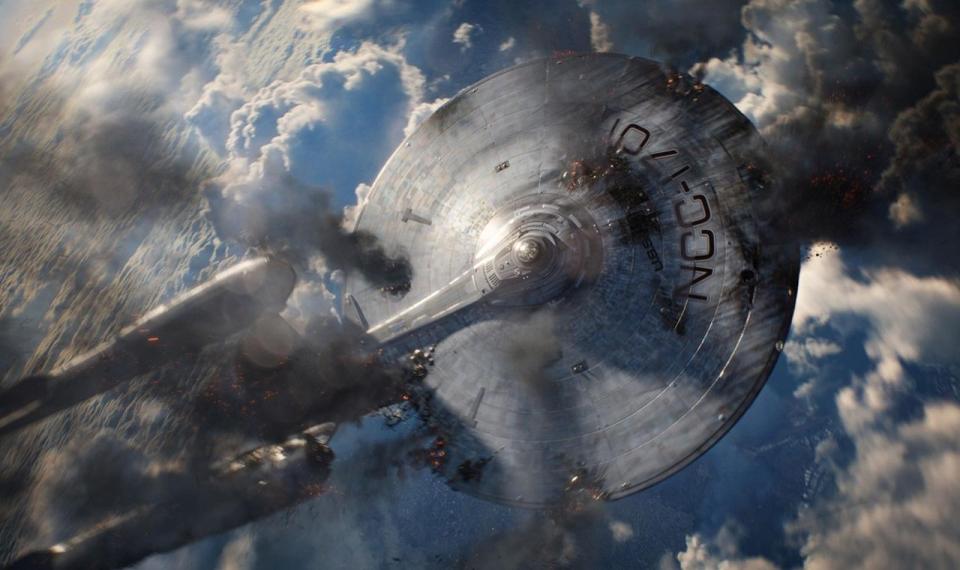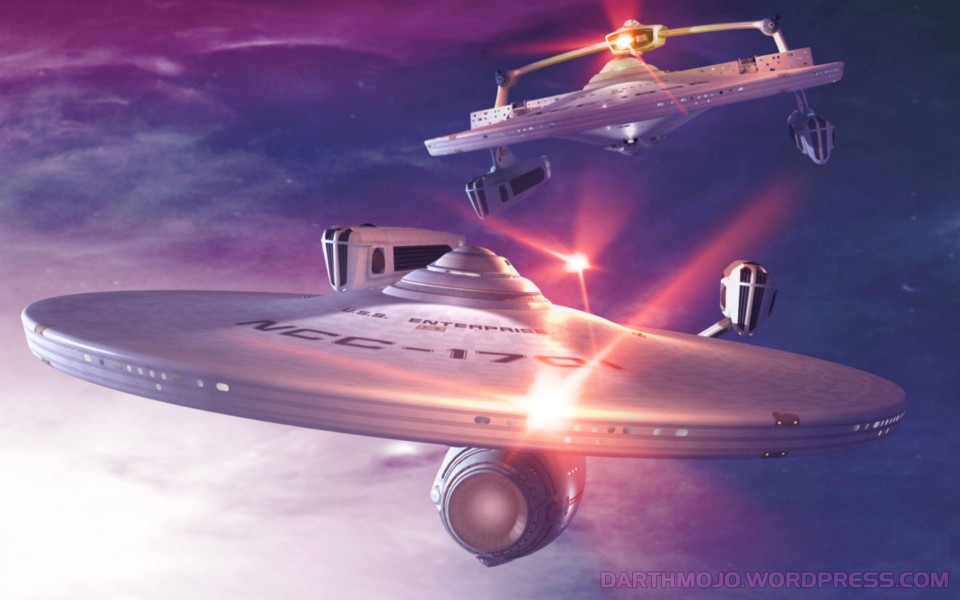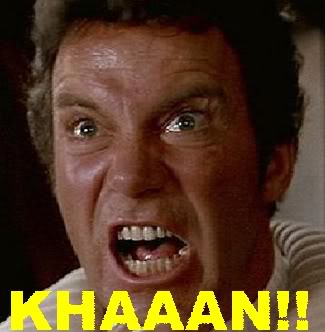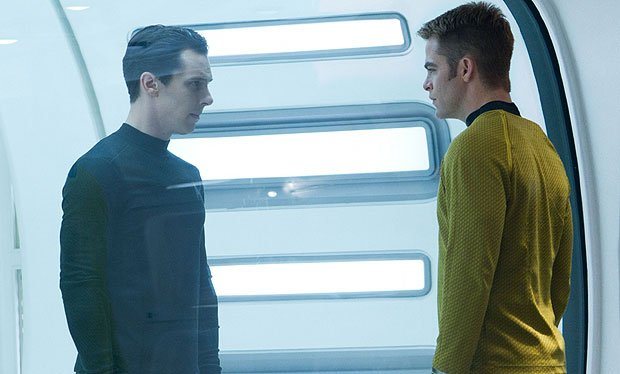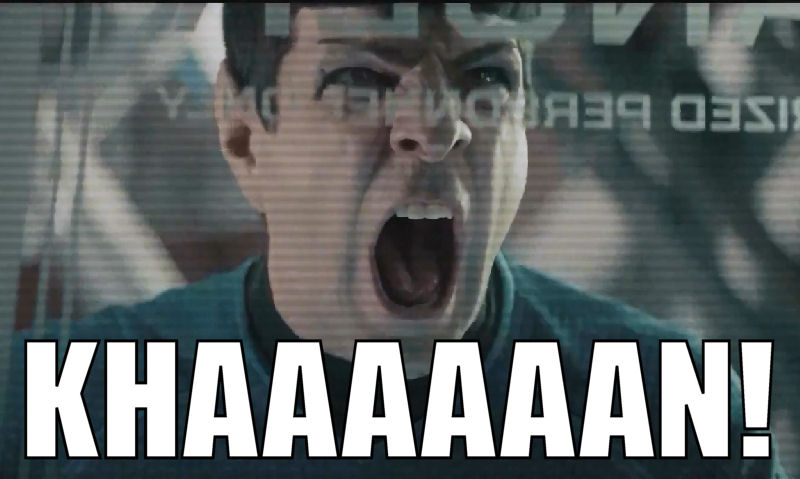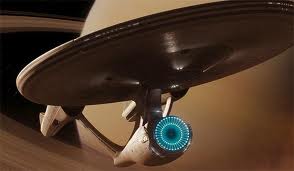Home » Posts tagged 'Klingon'
Tag Archives: Klingon
Freshness and Familiarity Part Two – Repackaging Star Trek
SPOILER WARNING
Star Trek Into Darkness (J. J. Abrams, 2013) constitutes a variation in the practice of re-launching previous texts and franchises. Whereas Star Trek (Abrams, 2009) was a re-launch of the Star Trek franchise as a whole, Star Trek Into Darkness combines features of both the sequel and the remake (Semake? Requel?), that repackages elements from previous Trek instalments into a new form that is influenced by its 21st century production context. STID’s narrative follows on from Star Trek, developing the relationships between Kirk (Chris Pine), Spock (Zachary Quinto), Uhura (Zoe Saldana) etc., and also expands the universe established in Star Trek, especially the aftermath of the attacks of Captain Nero (Eric Bana) and the destruction of Vulcan, as well as the Federation’s uneasy relationship with the Klingon Empire. But STID also remakes Star Trek II: The Wrath of Khan (Nicholas Meyer, 1982), updating it with 21st century sensibilities and re-interpreting the mythos around Khan (Benedict Cumberbatch). This repackaging creates particular tensions within the film text, leading to frustrations for viewers and interesting areas for consideration.
Henry Jenkins and Billy Proctor give in-depth (and very funny) critiques of the film, and Rob Bricken writes highly inventive criticisms of STID’s relationship with Star Trek in general and with TWOK (two can play that game) in particular. These writers demonstrate both dissatisfaction with the film on its own terms, and its perceived besmirching of a treasured text. I consider myself a dedicated Trekker, but TWOK never seemed that great to me, which might explain why I was less bothered with the earlier film being referenced in STID. Let us not forget that referencing or remaking or even contradicting an earlier text need not impinge upon the integrity of the original or one’s enjoyment of it. TWOK stands on its own whether you consider STID or not, much like the originals of Halloween, A Nightmare on Elm Street, The Hills Have Eyes, Friday the 13th, Psycho, Ocean’s Eleven, Get Carter, Alfie, The Italian Job, Ringu and other films that have been remade (there are a lot). Even if the remake is terrible, it need not tarnish your enjoyment of the original. I have never understood the obsession with the original, that which must not be distorted or besmirched because it constitutes some form of sacrilege. The responses to STID have been thankfully moderate, at least in comparison to Star Wars fans who protest that their childhood was somehow raped by Yoda’s pinball act in Attack of the Clones (George Lucas, 2002). They’re just films, people.
Sorry, got side-tracked there. There is much to criticise in STID. The shot of Carol Marcus (Alice Eve) in her underwear is gratuitous and annoying (no, I will NOT stick a picture of it on here). Many of the plot conveniences and gaps in logic are nonsensical, such as the Enterprise being hidden underwater to avoid being seen by the local inhabitants. Would it not have been better hidden in planetary orbit? In addition, the naivety of Starfleet in relation to “John Harrison” is rather striking. Harrison is perfectly placed to take advantage of Starfleet protocol in order to attack its command elite, yet no one thinks of this vulnerability until Kirk does just at the most dramatic moment in order to demonstrate that he is ahead of the curve. Later, the Enterprise as well as the dreadnought vessel Vengeance are heavily damaged and fall into Earth’s atmosphere, despite not having actually been in orbit. I don’t expect scientific accuracy, but would it have killed them to have the ships actually fighting in orbit?
The falling-out-of-orbit leads to the biggest absurdity of the whole film, which is that the correct process for warp core realignment is well-placed kicks. That’s right, an enormously powerful, dangerous, already damaged and unstable nuclear reactor is put back into working order with repeated, well-placed kicks. Maybe they should have tried that at Chernobyl. While Spock had to perform a similar task in TWOK, he had to rearrange some handheld objects in a delicate operation. (Actually, both instances of radiation contradict general Star Trek science – the warp core is run by matter-antimatter infusion, not nuclear power, so there should be no radiation anyway. It can be unstable, breach and cause a massive explosion, as seen in Star Trek: Generations [David Carson, 1994], but radiation is a pure plot convenience to allow agonising sacrifice.) STID’s intercutting between Kirk kicking the core and the ship spiralling through the clouds is very dramatic, but if you stop to think about it, it’s actually very silly.
The warp core sequence demonstrates both the strength and weakness of Abrams’ directorial approach. His aesthetic is highly dynamic, with extensive use of mobile, handheld camera with a slight wobble, and the ubiquitous lens flare that he is seemingly in love with. The screenplay by Roberto Orci, Alex Kurtzman and Damon Lindelof may have holes you could fly the Enterprise through, but with the plot whipping by at warp speed it is easy to miss these gaps in logic. But is this not rather patronising on the part of the filmmakers? The implication is “Don’t worry about the plot, kids, just look at the shiny-shiny while we shoot through space and everything is so coooooooool!” STID is certainly entertaining, but the care and precision of Gene Roddenberry and especially Ronald D. Moore, Michael Piller and Ira Steven Behr is missing. This is a difference between television and film – the contained narrative of a movie frequently does not have the space to develop fictional worlds and their infrastructure. When Star Trek movies have inconsistencies, like everyone in Generations forgetting that the warp core could be ejected, they are only apparent to dedicated Trekkers. With Abrams’ films, I don’t start questioning the gaps in logic until afterwards, because I am enjoying the film too much to care. When I do think about it, it is rather patronising, but not so much that it makes me die a little inside. The previous Star Trek movies have a more coherent internal logic, but they are a rather more sedate.
Not that they lack in action (despite the derogatory term, Star Trek: The [Slow] Motion Picture [Robert Wise, 1979]). Several of the earlier films feature spectacular space battles, including The Undiscovered Country (Nicholas Meyer, 1992), First Contact (Jonathan Frakes, 1996), Nemesis (Stuart Baird, 2002) and The Wrath of Khan, just one of several elements of that earlier film that are repackaged in this latest offering. In TWOK, the badly damaged Enterprise battles another Starfleet vessel, the Reliant, commandeered by Khan; in STID, the badly damaged Enterprise battles another Starfleet vessel, the Vengeance, first under the command of Admiral Marcus (Peter Weller) and then commandeered by Khan (notice a pattern emerging?). Cunning and guile are the key weapons used to achieve victory in both cases, although STID features more lens flare.
A strength of Abrams’ warp speed approach to visual storytelling, however, is that it does allow for moments of world-building that previous Star Trek films neglected, as the vast majority of action in earlier films is confined to the Enterprise. First Contact and The Voyage Home (Leonard Nimoy, 1986) largely take place on Earth, but these are both time travel narratives and do not feature the infrastructure of Starfleet or Earth in the 23rd or 24th centuries. Abrams’ version spends more time on Earth, indeed in interviews Abrams mentioned that after making Star Trek, he wanted to spend time in the cities. Star Trek and Star Trek Into Darkness depict Earth in the 23rd century, the utopia of Roddenberry’s vision as there is no indication of poverty, class or even capitalism (although commerce is neatly avoided). But there is still trouble in paradise, as some diseases cannot be cured except by Khan’s super-blood, and men like Admiral Marcus still possess defensive mentality.
This mentality manifests as the covert organisation Section 31, an entity that appeared in several episodes of Deep Space Nine. This unsavoury agency of the Federation was responsible for very questionable activities during the Dominion War story arc of DS9, in which the agency was described as having existed since the birth of the Federation (it also features in a number of Star Trek novels). Its presence in STID is a demonstration of a less-than-perfect future, and a further element in the repackaging of Star Trek. Another element is Khan’s age of over 300 which would place his birth in the late 20th century. In his original incarnation, Khan Noonien Singh (Ricardo Montalban) led a revolt against humanity in the 1990s, the revolutionaries sentenced to cryogenic exile in deep space. I didn’t notice Eugenics Wars in the 1990s, so the mention of this piece of 1960s future history is anachronistic to the 21st century viewer. But its inclusion demonstrates fidelity to the original, the wibbly-wobbly, timey-wimey relationship between Star Trek á la Roddenberry and Star Trek á la Abrams. Proctor comments that Star Trek 2009 was not technically a reboot, since its narrative connects to that of the original Star Trek, rather than working as a completely independent narrative like Batman Begins (Christopher Nolan, 2005), Casino Royale (Martin Campbell, 2006) or The Amazing Spider-Man (Marc Webb, 2012). Khan’s history is a further demonstration that this narrative is not separate from previous Trek, and that STID’s repackaging is a hybrid of sequel and remake. Much as Spock Prime (Leonard Nimoy) told Kirk that he and Spock are destined to have a great friendship, it also seems that Kirk and Khan are destined to clash.
Casting Khan as a wronged terrorist, rather than a revenge-crazed despot, articulates STID in a post-9/11 framework. Admiral Marcus justifies his militarisation of Starfleet as a response to the terrorist attack of Nero – Earth needs to be prepared against future attacks and the looming threat of war with the Klingons. You might therefore expect Marcus to be a little more paranoid about the 20th century superman he has been blackmailing, but again, only in so far as it serves the plot. Marcus resorts to extreme measures after Khan’s attack, sending Kirk and the Enterprise off to kill Khan before arriving in the Vengeance to kill them as well, but maybe he should have kept Khan on a tighter leash to begin with. But as Hitchcock said, then there wouldn’t be a film.
Marcus and Khan’s relationship though does create a further dimension which TWOK lacked – making Khan sympathetic. Ricardo Montalban’s Khan is crazed for revenge – the tagline informs the viewer of what to expect: “At the end of the universe lies the beginning of vengeance” (the name of Marcus’ dreadnought may be a further inter-textual reference). But Benedict Cumberbatch’s Khan has been coerced into developing new weapons and defence systems. Placing Khan under duress makes him more sympathetic and interesting; his main motivation is to protect his people and at one point he and Kirk form an alliance against their common enemy Marcus. This was one of the most satisfying elements of STID for me – take the original clash between Khan and Kirk and turn it around. It made Khan (perhaps ironically) more human, especially as the key to defeating him was his compassion for his own people. Some elements of TWOK were repackaged less successfully, such as the death of Kirk and Spock’s anguished roar:
It may be emotionally powerful, but perhaps it is an inter-textual step too far.
The treatment of Khan encapsulates the repackaging of TWOK that STID performs. STID repackages the iconic moments of TWOK with a different emphasis. This emphasis comes from the film’s concern with terrorism and violence, the Darkness that is Trekked into. Adam Ericksen discusses this in a fascinating reading of the film as the antidote to terror, rather than the War on Terror (which is apparently over). Kirk is initially committed to finding Khan and avenging the death of Captain Christopher Pike (Bruce Greenwood), but contravenes Marcus’ direct order (Jim Kirk, insubordinate? Shocking!) and takes Khan into custody, after punching him ineffectually a few times (violence solves nothing). Spock is consumed by grief and rage over the death of Kirk and attempts to kill Khan, but crucially Khan must live so that Kirk can be resurrected (sparing us Star Trek: The Search for Kirk). Marcus’ journey was into darkness because he saw violence and militarism as the solution to threats like that of Nero and the anticipated war with the Klingons, and he exploited Khan in serve this end. Khan’s journey into darkness is motivated by a massive superiority complex and fuelled by anger and, initially, Kirk and Spock both seek retribution. But crucially, when both of them could kill Khan, they do not, because killing is never the answer. STID may journey into darkness, but there is light at the end of the torpedo tube.
Through its engagement with violence and retaliation, STID repackages the features of TWOK in relation to its 21st century context. Much of Star Trek’s ideology, such as the platitudes espoused by Captain Picard in First Contact, can seem naïve in an era of violent clashes all over the world. Earlier decades were not necessarily more peaceful, but we had not seen planes fly into buildings back then, a contemporary trauma echoed in STID when Khan pilots the Vengeance’s death plunge into San Francisco. Furthermore, we did not have hatemongering assailing us from every other website, even if it is satirical. STID demonstrates that even in today’s cynical and embittered times, there is still a place for Gene Roddenberry’s optimistic vision of the future. Kirk and Spock both turn away from violent revenge, and Kirk’s speech at the end of the film emphasises the importance of and need to turn away from violence. For it is when we put aside violence, and encourage life instead of death, that we can truly go where no one has gone before.


